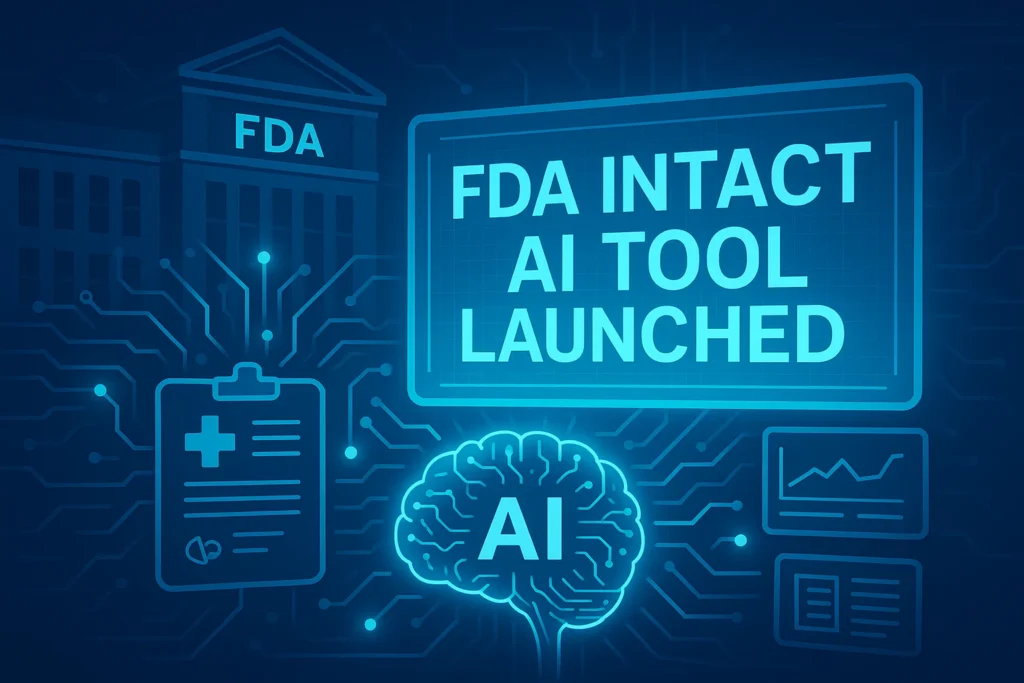In a decisive move to modernize healthcare oversight, the U.S. Food and Drug Administration (FDA) has launched its first-ever agency-wide generative AI tool called INTACT, internally referred to as “Elsa.” The tool has already begun to transform the agency’s regulatory and operational landscape, drastically reducing review times and streamlining critical decision-making processes.
Actually, what is INTACT or Elsa?
INTACT is referred to as “Elsa”, is the FDA’s first agency-wide generative AI assistant. Powered by large language models, it parses internal documents, drafts summaries, generates code, and compares regulatory labels—all within a high-security GovCloud infrastructure
INTACT is designed to assist FDA reviewers by automating repetitive, data-heavy tasks—allowing them to focus more deeply on scientific assessment and regulatory judgment. According to internal pilot data, tasks that previously took scientific staff two to three days to complete can now be done in as little as six minutes. This not only boosts internal productivity but also accelerates timelines for drug approvals, medical device evaluations, and inspection prioritization.
Built on a large language model infrastructure, INTACT operates within AWS’s GovCloud, ensuring compliance with strict federal data protection protocols. The FDA made it clear that the tool does not train on any industry-submitted data, safeguarding the confidentiality of proprietary information from pharmaceutical companies and medical device manufacturers.
Elsa is already being used to assist in five key regulatory areas: clinical protocol reviews, summarizing adverse event reports, comparing product labels, identifying high-risk inspection sites, and even generating code for structuring nonclinical study databases. These were all previously time-consuming tasks that required hours of staff input.
For example, clinical trial protocols often span hundreds of pages and are written in dense technical language. INTACT can now summarize these documents, identify key design elements, and extract critical data in a fraction of the time it would take a human reviewer. Similarly, when it comes to drug safety, the tool can rapidly sift through hundreds of adverse event reports and summarize the most concerning trends—something that could previously slow down post-market surveillance.
The pilot program, tested internally across several FDA centers, proved to be such a success that full deployment of INTACT was completed ahead of its planned June 30 deadline—and under budget. According to Jinzhong Liu, Deputy Director at the Office of Computational Science within FDA’s Center for Drug Evaluation and Research, the time saved was “nothing short of extraordinary.” He noted that AI is already reshaping how they manage the ever-growing volume of data without compromising the rigor expected from federal regulators.
This strategic move is also being praised for its responsible AI deployment. INTACT operates within the FDA’s internal network and only uses FDA-generated documents and data. This eliminates the risk of exposing confidential information to external models, a growing concern in both public and private sector AI deployments. Moreover, all outputs generated by the system are auditable, giving human reviewers full visibility into how conclusions were reached and allowing them to override or modify outputs if needed.
Jeremy Walsh, FDA’s Chief AI Officer, emphasized that this is not just a pilot or an isolated test—it’s a full integration of generative AI into the FDA’s day-to-day workflow. “We’re not replacing our scientists,” Walsh said, “we’re enhancing their ability to work faster, more accurately, and with greater insight.”
Beyond internal gains, the wider implications of this tool are significant. In a time when the FDA faces growing pressure to accelerate drug approvals and broaden post-market safety oversight, AI tools like INTACT can be a game-changer. The speed and scale at which it can process regulatory data has the potential to reduce drug review backlogs, shorten approval timelines, and allow the agency to monitor emerging risks more proactively.
The timing couldn’t be more urgent. The explosion of clinical research, personalized medicine, and AI-driven diagnostics means the FDA must deal with increasingly complex regulatory submissions. Having a tool that can digest, analyze, and organize these submissions with minimal lag is not just a convenience—it’s a necessity for maintaining both innovation and public safety.
The FDA plans to expand INTACT’s capabilities further in the coming months. Upcoming features may include integration with visual data tools, broader coverage of real-world evidence analysis, and more advanced generative report-building features. Meanwhile, staff across all FDA departments are receiving training to ensure the tool is used effectively and responsibly.
Critics and industry observers will be watching closely, particularly when it comes to transparency, hallucination risk, and reproducibility of AI outputs. But so far, early feedback from inside the agency is overwhelmingly positive. If INTACT continues to deliver on its promises, it could become a model for how other government agencies—nationally and globally—integrate artificial intelligence into complex regulatory systems.
Ultimately, the FDA’s rollout of INTACT represents more than just a software upgrade. It’s a signal that the agency is committed to embracing innovation not just in the products it regulates, but in how it regulates them. It reflects a shift in mindset—from being a watchdog of the past to a data-powered guardian of the future.
